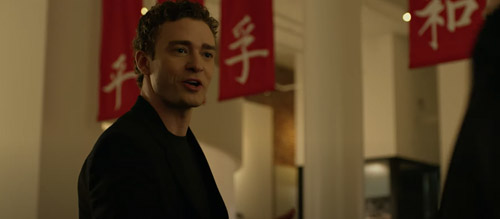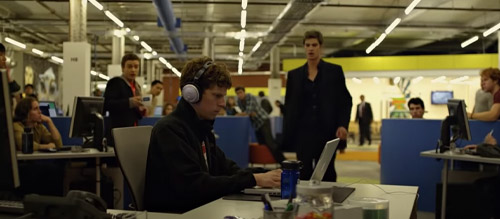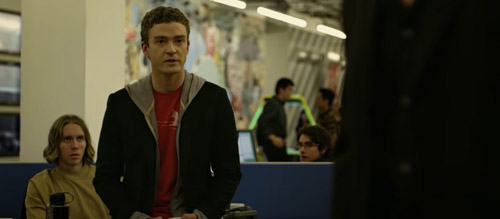Feeling Blue, Facebook? The Colour Symbolism of The Social Network
This article was written exclusively for The Film Magazine by Kristina Murkett.
David Fincher’s films are known for a lot of things. They are known for their non-linear narratives; their dark, stylized realism; and their locked camera movements. Many of his films are also known for their neo-noir aesthetics, and much of Fincher’s signature style comes from his preference for wide-angle shots over close ups, oppositional lighting over natural illumination, and claustrophobic city settings over epic landscapes.
Yet one of the more subtle (but equally sublime) features of his films is his use of colour. From the heavy desaturation of The Girl With The Dragon Tattoo to the sickly yellow-green hues of ‘Mindhunter’, colour is an integral part of Fincher’s visual storytelling. Colour is used to create atmosphere, to provoke particular emotions, to communicate key ideas and to track characters’ journeys. Nowhere is this seen more powerfully than in The Social Network, which celebrates its tenth anniversary this year.
Adapted from Ben Mezrich’s book “The Accidental Billionaires”, Fincher’s infamous biopic portrays the founding of Facebook and the resulting lawsuits. Fincher worked with cinematographer and long-term collaborator Jeff Cronenweth, who was also Director of Film for Fight Club, The Girl With The Dragon Tattoo and Gone Girl.
In an interview about making the film, Cronenweth stated that his mission was to come up “with a visual quality, which was naturalistic, so it won’t wrench you out of the very human drama, but also has a few bold, expressionistic undertones and some subtle stylization… for emotional amplification.”
He also noted that “the moral compass of the story is murky and grey, and the ethics don’t play out with any sense of certainty about the right answers, so we needed to match this with the visual tones. We decided to mute the colour palette quite heavily in the college scenes, and keep a limited depth-of-field to make the place feel claustrophobic in contrast to San Francisco.”
This sense of oppressiveness and moral ambiguity is executed exquisitely in the early bar/break-up scene between Mark Zuckerberg (Jesse Eisenberg) and Erica Albright (Rooney Mara). The monochromatic murkiness of the scene, which is made up almost entirely of different shades of brown, not only creates an uncomfortable, unpleasant environment, but also serves as a visual metaphor for Zuckerberg’s narrow-minded rigidity.
As you watch the scene, the monotony of the colours seems to match the monotony of the dialogue – Zuckerberg makes a series of pedantic, verbal faux-pas until Albright eventually exclaims that “dating you is like dating a stairmaster.” Interestingly, throughout this scene Albright and Zuckerberg are almost never seen in the shot together, which mirrors their increasing distance and polarising outlooks; neither of them can take into account the other’s point of view. The scene, like many others, also reminds us that Zuckerberg is an outsider through isolating him within the frame despite the busy, crowded setting.
On a microlevel therefore, the colours in this scene illustrate Zuckerberg’s limited, almost obsessive outlook. However, they also work on a macro level, by embodying the insular, inward-looking, almost incestuous nature of college environments. It is no coincidence that the scene starts with Albright teasing Zuckerberg about his “finals clubs OCD,” to which Zuckerberg infuriatingly replies, “It’s final clubs, not finals clubs.” His ambition may well border on addiction, but this seemingly trivial argument is hugely important. It not only explains his motivations but also why Facebook initially was such a success; in this claustrophobic college world, nothing is more important than exclusivity, privilege, and networking.
As we leave the confines of campus and move towards the bright lights of the big cities, the colours in the film do indeed become more expressionistic. Cronenweth uses colour as an important foreshadowing tool, and as the emotional, financial and social stakes of their start-up are raised, more colours are added into the mix. For example, Zuckerberg and Eduardo Saverin (Andrew Garfield) first meet slippery smooth-talker Sean Parker (Justin Timberlake) in a Chinese restaurant, where the usual desaturated, yellowish palette is suddenly interrupted by vibrant, ominously red banners behind Parker.
The camera once again flits between lone shots of Parker and Saverin to highlight their opposing positions and foretell their inevitable conflicts; the glimpses of red behind both of them suggest that neither is going down without a fight. Meanwhile, the scene is interrupted by voiceovers and flashforwards of Saverin’s testimony, as he gloomily reminisces that “a psychiatrist would say that [Parker] is paranoid… and delusional.” The use of red here is clearly a warning sign: Parker is also associated with red in the scene where he sleeps with college student Amelia Ritter (Dakota Johnson), who is also wearing red underwear, and in the red cups shown in the various parties he throws; both symbols of his destructive behaviours.
As the conflicts continue to grow, we move away from a muted colour palette with an occasional discordant colour to a more complementary colour scheme composed primarily of yellows and blues. In the climactic showdown in which Saverin confronts Zuckerberg about his diluted shares in the company, the camera tracks Saverin as he storms through the office, walking past bright blue office dividers and neon yellow backdrops – diametrically opposing shades on the colour wheel which symbolise how far they have grown apart.
Saverin is goaded by Parker, who, unsurprisingly, is wearing a red top (a literal red flag to a charging bull). Parker may be excruciatingly smug, but his red outfit stands out amongst the abundance of blue and yellow – a visual reminder that he doesn’t belong there either.
As the gravity of the situation dawns on Saverin, a further realisation hits: “Please tell me this isn’t because I got into The Phoenix.” The colour palette may have changed from the start of the film, but Zuckerberg is unable to move on – he is still alone in the frames, still alienated from those around him over petty jealousies.
Indeed, in the final scene of the film, we see the blue of the night sky contrasted against the yellow lights of the office, and Zuckerberg alone at his computer looking up Erica on Facebook. The fact that the contrasting yellows and blues are still there suggests that there is still ongoing conflict; the fact that he is alone suggests that this conflict is now internal rather than external. As his lawyer says, “You’re not an asshole Mark, you’re just trying so very hard to be one.”
Written by Kristina Murkett
You can support Kristina Murkett in the following places:
Instagram – @cultureinthetimeofcorona
Twitter – @kristinamurkett






